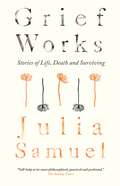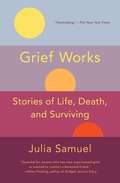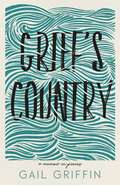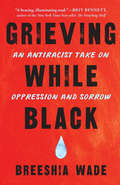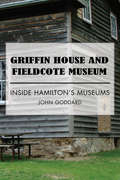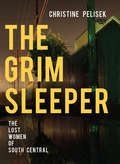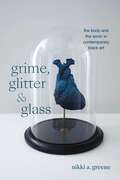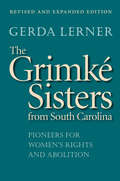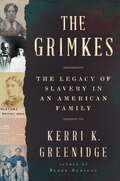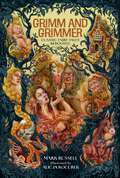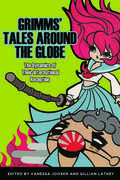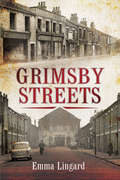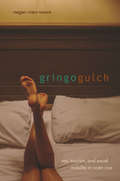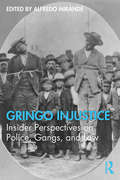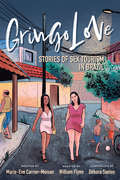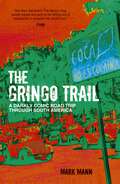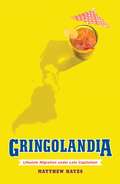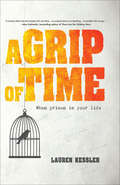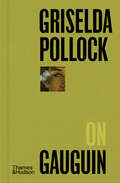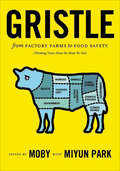- Table View
- List View
Grief Works: Stories of Life, Death and Surviving
by Julia SamuelA warm, moving and practical guide to grief from a leading bereavement counsellor, Grief Works features deeply affecting case studies of the author's clients, which will appeal to readers of Atul Gawande's Being Mortal, Stephen Grosz's The Unexamined Life and Paul Kalanithi's When Breath Becomes Air. <P><P>Death is the last taboo in our society, and grief is still profoundly misunderstood. So many of us feel awkward and uncertain around death, and shy away from talking honestly with family and friends. <P><P>Grief Works is a compassionate guide that will inform and engage anyone who is grieving, from the "expected" death of a parent to the sudden unexpected death of a small child, and provide clear advice for those seeking to comfort the bereaved. <P><P>With deeply moving case studies of real people's stories of loss, and brilliantly accessible and practical advice, Grief Works will be passed down through generations as the definitive guide for anyone who has lost a loved one, and revolutionize the way we talk about life, loss and death.
Grief Works: Stories of Life, Death, and Surviving
by Julia SamuelAn instant bestseller in the UK, Grief Works is a profoundly optimistic and compassionate handbook for anyone suffering a loss—from the expected death of a parent to the sudden death of a child or spouse—as well as a guide for those who want to help their grieving loved ones.Death affects us all. Yet it is still the last taboo in our society, and grief is still profoundly misunderstood. So many of us feel awkward and uncertain around death, and shy away from talking honestly with family and friends. Julia Samuel, a grief psychotherapist, has spent twenty-five years working with the bereaved and understanding the full repercussions of loss. In Grief Works Samuel shares case studies from those who have experienced great love and great loss—and survived. People need to understand that grief is a process that has to be worked through, and Samuel shows if we do the work, we can begin to heal. The stories here explain how grief unmasks our greatest fears, strips away our layers of protection, and reveals our innermost selves. Intimate, clear, warm, and helpful, Grief Works addresses the fear that surrounds death and grief and replaces it with confidence. Samuel is a caring and deeply experienced guide through the shadowy and mutable land of grief, and her book is as invaluable to those who are grieving as it is to those around them. She adroitly unpacks the psychological tangles of grief in a voice that is compassionate, grounded, real, and observant of those in mourning. Divided into case histories grouped by who has died—a partner, a parent, a sibling, a child, as well section dealing with terminal illness and suicide—Grief Works shows us how to live and learn from great loss.
Grief's Country: A Memoir in Pieces (Made in Michigan Writers Series)
by Gail GriffinGail Griffin had only been married for four months when her husband’s body was found in the Manistee River, just a few yards from their cabin door. The terrain of memoir is full of stories of grief, though Grief’s Country: A Memoir in Pieces is less concerned with the biography of a love affair than with the lived phenomenon of grief itself—what it does to the mind, heart, and body; how it functions almost as an organism. The book’s intimacy is at times nearly disarming; its honesty about struggling through grief’s country is unfailing. The story is told "in pieces" in that it is ten essays of varying forms, punctuated by four original poems, that examine facets of traumatic grief, memory, and survival. While a reader will perceive a forward trajectory, the book resists anything like a clear chronology, offering a picture of deep grief as something that defies the linear and explodes time. "A Strong Brown God" tells the story of two of Griffin’s significant relationships—with her husband, Bob, and with the Manistee River—and includes the history of what drew them all together. "Grief’s Country" follows Griffin from the morning after Bob’s death through the first disoriented, fractured months of PTSD. "Heartbreak Hotel" takes Griffin on a tragicomical flight the first Christmas after Bob’s death to a Jamaican resort—which includes an unscheduled stop at Graceland—where she contemplates the notions of home and haven. Grief’s Country will speak directly to anyone who has lost a dearly loved one, offering not one story but ten different faces of grief to contemplate. It will also appeal to general readers of memoir, including teachers and students of nonfiction, especially as it includes a variety of formal models. Those interested in the subject area of death and dying will find it useful as a book that bypasses recovery narratives, truisms, and "stages of grief" to get as close as possible to the experience itself.
The Grieving Body: How the Stress of Loss Can Be an Opportunity for Healing
by Mary-Frances O'ConnorThe follow-up to celebrated grief expert, neuroscientist, and psychologist Dr. Mary-Frances O’Connor’s The Grieving Brain focuses on the impact of grief—and life’s other major stressors—on the human body. Coping with death and grief is one of the most painful human experiences. While we can speak to the psychological and emotional ramifications of loss and sorrow, we often overlook its impact on our physical bodies. Dr. Mary-Frances O’Connor specializes in the study of grief, and in The Grieving Body she shares vital scientific research, revealing imperative new insights on its profound physiological impact. As she did in The Grieving Brain, O’Connor combines illuminating studies and personal stories to explore the toll loss takes on our cardiovascular, endocrine, and immune systems and the larger implications for our long-term well-being.The Grieving Body addresses questions about how bereavement affects us, such as:Can we die of a broken heart?What happens in our bodies when we’re grieving?How do our coping behaviors affect our physical health?What is the cognitive impact of grief?Why are we more prone to illness during times of enormous stress?and moreResearch-backed, warm, and empathetic, The Grieving Body is an essential, hopeful read for those experiencing loss as well as their supportive friends and family.The Grieving Body is illustrated with black-and-white charts and graphs.
Grieving While Black: An Antiracist Take on Oppression and Sorrow
by Breeshia WadeAn exploration of grief and racial trauma through the eyes of a Black end-of-life caregiver.Most of us understand grief as sorrow experienced after a loss—the death of a loved one, the end of a relationship, or a change in life circumstance. Breeshia Wade approaches grief as something that is bigger than what's already happened to us—as something that is connected to what we fear, what we love, and what we aspire toward. Drawing on stories from her own life as a Black woman and from the people she has midwifed through the end of life, she connects sorrow not only to specific incidents but also to the ongoing trauma that is part and parcel of systemic oppression.Wade reimagines our relationship to power, accountability, and boundaries and points to the long-term work we must all do in order to address systemic trauma perpetuated within our interpersonal relationships. Each of us has a moral obligation to attend to our own grief so that we can responsibly engage with others. Wade elucidates grief in every aspect of our lives, providing a map back to ourselves and allowing the reader to heal their innate wholeness.
Griffin House and Fieldcote Museum: Inside Hamilton's Museums
by John GoddardInside Hamilton’s Museums helps to satisfy a growing curiosity about Canada’s steel capital as it evolves into a post-industrial city and cultural destination. In this special excerpt we visit two sites, Griffin House and the Fieldcote Memorial Park and Museum. Griffin House honours one of Ancaster's earliest black settlers, Enerals Griffin, and pays tribute to the black slaves from the United States who fled to freedom in Upper Canada. Fieldcote Museum was built as private home and now functions as a gallery for exhibitions alternating between local history and the visual arts. John Goddard takes us on a detailed tour of the historic homes and gardens, providing fascinating historical background and insight.
Grilling Dahmer: The Interrogation Of "The Milwaukee Cannibal"
by Patrick Kennedy Robyn MaharajThe Milwaukee detective who interrogated the notorious serial killer shares a vivid chronicle of what was revealed during the weeks-long encounter. In the late hours of July 22, 1991, Detective Patrick &“Pat&” Kennedy of the Milwaukee Police Department was asked to respond to a possible homicide. Little did he know that he would soon be delving into the dark mind of one of America's most notorious serial killers, the &“Milwaukee Cannibal&” Jeffrey Dahmer. As the media clamored for details, Kennedy spent the next six weeks, sixteen hours a day, locked in an interrogation room with Dahmer. There the thirty-one-year-old killer described in lurid detail how he lured several young men to his apartment where he strangled, sexually assaulted, dismembered, and in some cases, cannibalized his victims. In Grilling Dahmer,Kennedy takes readers inside the mind of evil as he patiently, meticulously, listens to unspeakable horrors.
The Grim Sleeper: The Lost Women of South Central
by Christine PelisekThe inside story of one of the notorious and elusive serial killer who stalked the vulnerable, the young, and the ignored in 1980s Los Angeles—only to return in 2002.The Grim Sleeper was one of the most brutal serial killers in California history, preying on the women of South Central for decades. No one knows this story better than Christine Pelisek, the reporter who followed it for more than ten years. Based on extensive interviews, reportage, and information never released to the public, The Grim Sleeper captures the long, bumpy road to justice in one of the most startling true crime stories of our generation from his violent first crime while serving in the US Army to his inevitable death in prison."This upsetting account of a Los Angeles serial killer, written with passion by Christine Pelisek, an investigative crime reporter who spent 10 years working the case, blurts out a hard truth that no one wants to acknowledge . . . [She] tries to restore dignity to some of the victims by drawing sympathetic and carefully detailed life histories for each and every one of them." ―Marilyn Stasio, The New York Times Book Review
The Grimace of Macho Ratón: Artisans, Identity, and Nation in Late-Twentieth-Century Western Nicaragua
by Les FieldIn this creative ethnography Les W. Field challenges a post-Sandinista national conception of identity, one that threatens to constrict the future of subaltern Nicaraguans. Drawing on the works and words of artisans and artisanas, Indians, and mestizos, Field critiques the national ideology of ethnic homogeneity and analyzes the new forms of social movement that have distinguished late-twentieth-century Nicaragua. As a framework for these analytic discussions, Field uses the colonial-era play El Güegüence o Macho Ratón and the literature relating to it. Elite appropriations of El Güegüence construe it as an allegory of mestizo national identity in which mestizaje is defined as the production of a national majority of ethnically bounded non-Indians in active collaboration with the state. By contrast, Field interprets the play as a parable of cultural history and not a declaration of cultural identity, a scatological reflection on power and the state, and an evocation of collective loss and humor broadly associated with the national experience of disempowered social groups. By engaging with those most intimately involved in the performance of the play--and by including essays by some of these artisans--Field shows how El Güegüence tells a story about the passing of time, the absurdity of authority, and the contradictions of coping with inheritances of the past. Refusing essentialist notions of what it means to be Indian or artisan, Field explains the reemergence of politicized indigenous identity in western Nicaragua and relates this to the longer history of artisan political organization. Parting ways with many scholars who associate the notion of mestizaje with identity loss and hegemony, Field emphasizes its creative,productive, and insightful meanings. With an emphasis on the particular struggles of women artisans, he explores the reasons why forms of collective identity have posed various kinds of predicaments for this marginalized class of western Nicaraguans. This book will appeal to readers beyond the field of Latin American anthropology, including students and scholars of literature, intellectual history, women's studies, and the politics of ethnicity.
Grime, Glitter, and Glass: The Body and the Sonic in Contemporary Black Art (The Visual Arts of Africa and its Diasporas)
by Nikki A. GreeneIn Grime, Glitter, and Glass, Nikki A. Greene examines how contemporary Black visual artists use sonic elements to refigure the formal and philosophical developments of Black art and culture. Focusing on the multimedia art of Renée Stout, Radcliffe Bailey, and María Magdalena Campos-Pons, Greene traces the intersection of the visual’s sonic possibilities with the Black body’s physical, representational, and metaphorical use in art. She employs her concept of “visual aesthetic musicality” to interpret Black visual art by examining the musical genres of jazz and rap, along with the often-overlooked innovations of funk and rumba, within art historiography. From Bailey’s use of multilayered surfaces of glitter, mud, and recycled materials to meditate on Sun Ra’s Afrofuturism to Stout’s life-size cast of her own body that recalls funk musician Betty Davis to Campos-Pons’s performative and sculptural references to sugar that resonate with the legacy of Celia Cruz, Greene outlines how these artists use mediums such as molded glass sculptures, viscous wet plaster, and dazzling mannequin heads to enhance the manifestations of Black identity. By foregrounding the sonic elements of their work, Greene demonstrates that these artists use sound to make themselves legible, recognizable, and audible.
The Grimké Sisters from South Carolina
by Gerda LernerA landmark work of women's history originally published in 1967, Gerda Lerner's best-selling biography of Sarah and Angelina Grimke explores the lives and ideas of the only southern women to become antislavery agents in the North and pioneers for women's rights. This revised and expanded edition includes two new primary documents and an additional essay by Lerner. In a revised introduction Lerner reinterprets her own work nearly forty years later and gives new recognition to the major significance of Sarah Grimke's feminist writings.
The Grimkes: The Legacy Of Slavery In An American Family
by Kerri K. GreenidgePublishers Weekly • 10 BEST BOOKS OF 2022 New York Times • "15 Works of Nonfiction to Read This Fall", Best Books of November 2022 Boston Globe • "20 New Books We're Most Excited to Read This Fall" A stunning counternarrative of the legendary abolitionist Grimke sisters that finally reclaims the forgotten Black members of their family. Sarah and Angelina Grimke—the Grimke sisters—are revered figures in American history, famous for rejecting their privileged lives on a plantation in South Carolina to become firebrand activists in the North. Their antislavery pamphlets, among the most influential of the antebellum era, are still read today. Yet retellings of their epic story have long obscured their Black relatives. In The Grimkes, award-winning historian Kerri Greenidge presents a parallel narrative, indeed a long-overdue corrective, shifting the focus from the white abolitionist sisters to the Black Grimkes and deepening our understanding of the long struggle for racial and gender equality. That the Grimke sisters had Black relatives in the first place was a consequence of slavery’s most horrific reality. Sarah and Angelina’s older brother, Henry, was notoriously violent and sadistic, and one of the women he owned, Nancy Weston, bore him three sons: Archibald, Francis, and John. While Greenidge follows the brothers’ trials and exploits in the North, where Archibald and Francis became prominent members of the post–Civil War Black elite, her narrative centers on the Black women of the family, from Weston to Francis’s wife, the brilliant intellectual and reformer Charlotte Forten, to Archibald’s daughter, Angelina Weld Grimke, who channeled the family’s past into pathbreaking modernist literature during the Harlem Renaissance. In a grand saga that spans the eighteenth century to the twentieth and stretches from Charleston to Philadelphia, Boston, and beyond, Greenidge reclaims the Black Grimkes as complex, often conflicted individuals shadowed by their origins. Most strikingly, she indicts the white Grimke sisters for their racial paternalism. They could envision the end of slavery, but they could not imagine Black equality: when their Black nephews did not adhere to the image of the kneeling and eternally grateful slave, they were cruel and relentlessly judgmental—an emblem of the limits of progressive white racial politics. A landmark biography of the most important multiracial American family of the nineteenth century, The Grimkes suggests that just as the Hemingses and Jeffersons personified the racial myths of the founding generation, the Grimkes embodied the legacy—both traumatic and generative—of those myths, which reverberate to this day.
Grimm and Grimmer: Classic Fairy Tales Rebooted
by Mark RussellThis collection of fourteen reimagined Grimm's fairy tales from award-winning author Mark Russell offers a biting new perspective while proving the classics never go out of style. In the two hundred years since Jacob and Wilhelm Grimm first published their collection of fairy tales, things haven&’t gotten any less—ahem—grim. So tuck yourself in with some of the classic bedtime stories, retold by award-winning author Mark Russell. Grimm and Grimmer offers fourteen of the Brothers Grimm&’s finest stories—a mix of well-known tales including "Rapunzel" and "Cinderella," and ones you might not know, like "The Boy Who Didn&’t Know Fear"—reconceived for a twenty-first century while staying true to their roots At times both laugh-out-loud funny and darker than a wicked stepmother&’s heart, this captivating collection captures all the absurdities and anxieties of the world just outside our windows.
Grimms' Tales around the Globe: The Dynamics of Their International Reception
by Vanessa Joosen Gillian LatheyGrimms' fairy tales are among the best-known stories in the world, but the way they have been introduced into and interpreted by cultures across the globe has varied enormously. In Grimms' Tales around the Globe, editors Vanessa Joosen and Gillian Lathey bring together scholars from Asia, Europe, and North and Latin America to investigate the international reception of the Grimms' tales. The essays in this volume offer insights into the social and literary role of the tales in a number of countries and languages, finding aspects that are internationally constant as well as locally particular. In the first section, Cultural Resistance and Assimilation, contributors consider the global history of the reception of the Grimms' tales in a range of cultures. In these eight chapters, scholars explore how cunning translators and daring publishers around the world reshaped and rewrote the tales, incorporating them into existing fairy-tale traditions, inspiring new writings, and often introducing new uncertainties of meaning into the already ambiguous stories. Contributors in the second part, Reframings, Paratexts, and Multimedia Translations, shed light on how the Grimms' tales were affected by intermedial adaptation when traveling abroad. These six chapters focus on illustrations, manga, and film and television adaptations. In all, contributors take a wide view of the tales' history in a range of locales--including Poland, China, Croatia, India, Japan, and France. Grimms' Tales around the Globe shows that the tales, with their paradox between the universal and the local and their long and world-spanning translation history, form a unique and exciting corpus for the study of reception. Fairy-tale and folklore scholars as well as readers interested in literary history and translation will appreciate this enlightening volume.
Grimsby Streets
by Emma LingardA &“fascinating&” walk through the history of one English port town, told through the names of its streets—includes photos (Books Monthly). With a history that dates back to the days of the Vikings, Grimsby, on England&’s eastern coast, has served as a hub for shipping companies and fishermen and a home to generations of citizens. Arranged alphabetically, Grimsby Streets is a journey through time, examining the meanings and origins of many of the town&’s street names, from their association with the Danish settlers through to the Victorian era and the men who helped develop the town and build its surrounding docks. Names of the great and good who were forgotten until now are explored, as well as some of the many famous people who were born there, and where they lived. The book also covers numerous incidents that occurred on Grimsby's streets, providing colorful insight into the history of this once-famous fishing port and some of the many wonderful buildings that stood there. Included throughout are a selection of old photographs, some of which have never been published before, a reminder of what this town was like before change and demolition in the 1960s.
The Grind: Black Women and Survival in the Inner City
by Alexis S. McCurnFew scholars have explored the collective experiences of women living in the inner city and the innovative strategies they develop to navigate daily life in this setting. The Grind illustrates the lived experiences of poor African American women and the creative strategies they develop to manage these events and survive in a community commonly exposed to violence. Alexis S. McCurn draws on nearly two years of naturalistic field research among adolescents and adults in Oakland, California to provide an ethnographic account of how black women accomplish the routine tasks necessary for basic survival in poor inner-city neighborhoods and how the intersections of race, gender, and class shape how black women interact with others in public. This book makes the case that the daily consequences of racialized poverty in the lives of African Americans cannot be fully understood without accounting for the personal and collective experiences of poor black women.
Gringo Gulch: Sex, Tourism, and Social Mobility in Costa Rica
by Megan Rivers-MooreThe story of sex tourism in the Gringo Gulch neighborhood of San José, Costa Rica could be easily cast as the exploitation of poor local women by privileged North American men—men who are in a position to take advantage of the vast geopolitical inequalities that make Latin American women into suppliers of low-cost sexual labor. But in Gringo Gulch, Megan Rivers-Moore tells a more nuanced story, demonstrating that all the actors intimately entangled in the sex tourism industry—sex workers, sex tourists, and the state—use it as a strategy for getting ahead. Rivers-Moore situates her ethnography at the intersections of gender, race, class, and national dimensions in the sex industry. Instead of casting sex workers as hapless victims and sex tourists as neoimperialist racists, she reveals each group as involved in a complicated process of class mobility that must be situated within the sale and purchase of leisure and sex. These interactions operate within an almost entirely unregulated but highly competitive market beyond the reach of the state—bringing a distinctly neoliberal cast to the market. Throughout the book, Rivers-Moore introduces us to remarkable characters—Susan, a mother of two who doesn’t regret her career of sex work; Barry, a teacher and father of two from Virginia who travels to Costa Rica to escape his loveless, sexless marriage; Nancy, a legal assistant in the Department of Labor who is shocked to find out that prostitution is legal and still unregulated. Gringo Gulch is a fascinating and groundbreaking look at sex tourism, Latin America, and the neoliberal state.
Gringo Injustice: Insider Perspectives on Police, Gangs, and Law
by Alfredo MirandéThe recent mass shooting of 22 innocent people in El Paso by a lone White gunman looking to "Kill Mexicans" is not new. It is part of a long, bloody history of anti-Latina/o violence in the United States. Gringo Injustice brings this history to life, shedding critical light on the complex relationship between Latinas/os and the United States’ legal and judicial system. Contributors with first-hand knowledge and experience, including former law enforcement officers, ex-gang members, attorneys, and community activists, share insider perspectives on the issues facing Latinas/os and initiate a critical dialogue on this neglected topic. Essays examine the unauthorized use of deadly force by police and patterned incidents of lynching, hate crimes, gang violence, and racial profiling. The book also highlights the hyper-criminalization of barrio youth and considers wide-ranging implications from the disproportionate imprisonment of Latinas/os. Gringo Injustice provides a comprehensive and powerful look into the Latina/o community’s fraught history with law enforcement and the American judicial system. It is an essential reference for students and scholars interested in intersections between crime and communities of Color, and for use in Sociology, Latino Studies, Ethnic Studies, Chicano Studies, Criminology, and Criminal Justice.
Gringo Love: Stories of Sex Tourism in Brazil (ethnoGRAPHIC)
by Marie-Eve Carrier-MoisanIn the city of Natal in northeastern Brazil, several local women negotiate the terms of their intimate relationships with foreign tourists, or gringos, in a situation often referred to as "sex tourism." These women have different experiences, but they share a similar desire to "escape" the social conditions of their lives in Brazil. Based on original ethnographic research and presented in graphic form, Gringo Love explores the hopes, dreams, and realities of these women against a backdrop of deep social inequality and increasing state surveillance leading up to the 2014 World Cup and 2016 Olympic Games. It touches on important contemporary issues, including sexual economics, transnational mobility, romantic imaginaries, gender representation, race and inequality, and visual methods. The graphic story is accompanied by analysis and contextual discussion, which encourage readers to engage with the narrative and expand their understanding of the broader social issues therein.
The Gringo Trail: A Darkly Comic Road Trip through South America
by Mark MannMark Mann and his girlfriend Melissa set off to explore the ancient monuments, mountains and rainforests of South America. But for their friend Mark, South America meant only one thing: drugs. Sad, funny and shocking, The Gringo Trail is a darkly comic road-trip and a revealing journey through South America’s turbulent history.
Gringolandia: Lifestyle Migration under Late Capitalism (Globalization and Community)
by Matthew HayesA telling look at today&’s &“reverse&” migration of white, middle-class expats from north to south, through the lens of one South American city Even as the &“migration crisis&” from the Global South to the Global North rages on, another, lower-key and yet important migration has been gathering pace in recent years—that of mostly white, middle-class people moving in the opposite direction. Gringolandia is that rare book to consider this phenomenon in all its complexity.Matthew Hayes focuses on North Americans relocating to Cuenca, Ecuador, the country&’s third-largest city and a UNESCO World Heritage Site. Many began relocating there after the 2008 economic crisis. Most are self-professed &“economic refugees&” who sought offshore retirement, affordable medical care, and/or a lower–cost location. Others, however, sought adventure marked by relocation to an unfamiliar cultural environment and to experience personal growth through travel, illustrative of contemporary cultures of aging. These life projects are often motivated by a desire to escape economic and political conditions in North America. Regardless of their individual motivations, Hayes argues, such North–South migrants remain embedded in unequal and unfair global social relations. He explores the repercussions on the host country—from rising prices for land and rent to the reproduction of colonial patterns of domination and subordination. In Ecuador, heritage preservation and tourism development reflect the interests and culture of European-descendent landowning elites, who have most to benefit from the new North–South migration. In the process, they participate in transnational gentrification that marginalizes popular traditions and nonwhite mestizo and indigenous informal workers. The contrast between the migration experiences of North Americans in Ecuador and those of Ecuadorians or others from such regions of the Global South in North America and Europe demonstrates that, in fact, what we face is not so much a global &“migration crisis&” but a crisis of global social justice.
The Grip of Sexual Violence in Conflict: Feminist Interventions in International Law (Stanford Studies in Human Rights)
by Karen EngleContemporary feminist advocacy in human rights, international criminal law, and peace and security is gripped by the issue of sexual violence in conflict. But it hasn't always been this way. Analyzing feminist international legal and political work over the past three decades, Karen Engle argues that it was not inevitable that sexual violence in conflict would become such a prominent issue. Engle reveals that as feminists from around the world began to pay an enormous amount of attention to sexual violence in conflict, they often did so at the cost of attention to other issues, including the anti-militarism of the women's peace movement; critiques of economic maldistribution, imperialism, and cultural essentialism by feminists from the global South; and the sex-positive positions of many feminists involved in debates about sex work and pornography. The Grip of Sexual Violence in Conflict offers a detailed examination of how these feminist commitments were not merely deprioritized, but undermined, by efforts to address the issue of sexual violence in conflict. Engle's analysis reinvigorates vital debates about feminist goals and priorities, and spurs readers to question much of today's common sense about the causes, effects, and proper responses to sexual violence in conflict.
A Grip of Time: When Prison Is Your Life
by Lauren Kessler“The book provides insight into life inside a maximum-security prison while illuminating the benefits of the craft of writing. . . . compassionate.” —Publishers WeeklyA Grip of Time (prison slang for a very long sentence behind bars) takes readers into a world most know little about—a maximum-security prison—and into the minds and hearts of the men who live there. These men, who are serving out life sentences for aggravated murder, join a fledgling Lifers’ Writing Group started by award-winning author Lauren Kessler. Over the course of three years, meeting twice a month, the men reveal more and more about themselves, their pasts, and the alternating drama and tedium of their incarcerated lives. As they struggle with the weight of their guilt and wonder if they should hope for a future outside prison walls, Kessler struggles with the fiercely competing ideas of rehabilitation and punishment, forgiveness and blame that are at the heart of the American penal system. Gripping, intense, and heartfelt, A Grip of Time: When Prison Is Your Life shows what a lifetime with no hope of release looks like up-close.“Takes us on a compelling, intensely personal journey into the rarely glimpsed end point of our justice system . . . What dignity, meaning, and success these lifers achieve despite the system’s design.” —Edward Humes, Pulitzer Prize–winning author of Burned: A Story of Murder and the Crime That Wasn’t“A keenly observed and deeply felt narrative . . . so original and so compelling . . . it wouldn’t let me go.” —Alex Kotlowitz, national bestselling author of An American Summer
Griselda Pollock on Gauguin (Pocket Perspectives #6)
by Griselda PollockGriselda Pollock, feminist art historian and longstanding advocate of gender and racial inclusivity, unpacks the racist, sexist, and imperialist underpinnings of works created by Gauguin and others as they competed for preeminence in the European artistic avant-garde of the 1880s and '90s. Surprising, questioning, challenging, enriching: the Pocket Perspectives series presents timeless works by writers and thinkers who have shaped the conversation across the arts, visual culture, and history. Celebrating the undiminished vitality of their ideas today, these covetable and collectable little books embody the best of Thames & Hudson.
Gristle: From Factory Farms to Food Safety
by Miyun ParkThe musician and activist offers &“a collection of compelling, well-researched essays . . . shining light on the world of agribusiness&” and Big Meat (Publishers Weekly). For everyone from omnivores to vegans, this eye-opening guide offers food for thought on today&’s meat industry. Moby, renowned musician and passionate vegan, and Miyun Park, leading food policy activist, bring together experts from diverse backgrounds including: farming, workers&’ rights activism, professional athletics, science, environmental sustainability, food business, and animal welfare advocacy. Together, they eloquently lay out how industrial animal agriculture unnecessarily harms workers, communities, the environment, our health, our wallets, and animals. In the tradition of Michael Pollan&’s The Omnivore&’s Dilemma, Gristle combines hard-hitting facts with a light touch and includes informative charts and illustrations depicting the stark realities of America&’s industrial food system. Contributors include: Brendan BrazierLauren BushChristine Chavez and Julie Chavez RodriguezMichael Greger, MDSara Kubersky and Tom O&’HaganFrances Moore Lappé and Anna LappéJohn MackeyDanielle Nierenberg and Meredith NilesWayne PacellePaul and Phyllis Willis
